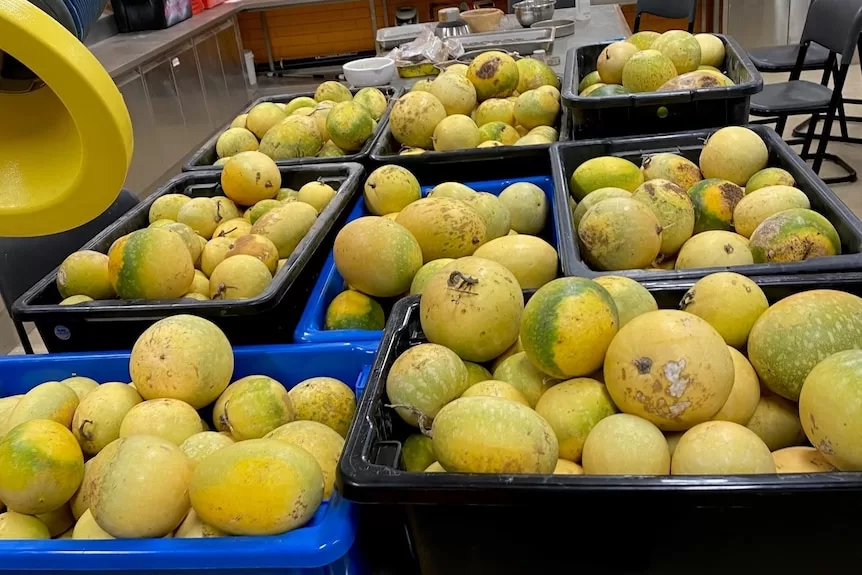- In short: A world-first study has found enzymes from the prickly paddy melon weed can create a sustainable alternative to cement.
- The weed costs the agricultural industry millions of dollars a year.
- What’s next? Experts say further research is needed but construction, mining and forestry industries could benefit from the paddy melon’s enzymes.
An invasive weed that has long plagued the Australian agricultural industry could become a game-changing economic crop due to its potential to produce a cement alternative.
Prickly paddy melon costs the agricultural industry around $100 million a year in lost grain yields, cattle deaths and control measures.
The weed is particularly challenging because it has a long germination period and produces many seeds that remain viable in the soil for years.
But now researchers say enzymes produced by the paddy melon could be used to create a more sustainable form of cement and prevent soil erosion.
Transforming a troublesome weed
In a world-first study, researchers at the University of South Australia screened 50 native plants and weeds to find cheaper and more environmentally friendly sources of urease enzymes that could be produced in bulk to strengthen soil.
Paddy melon enzymes are cheaper and more sustainable than commercial enzymes used to create cement and stabilise soils, according to UniSA geotechnical engineer Mizanur Rahman.
“Not only have we found a natural alternative to other commercial enzymes, but we could solve a very expensive problem for the agricultural industry by harvesting these weeds, reducing the availability of seeds for spreading, preserving biodiversity and growing paddy melon as a commercial crop,” Professor Rahman said.
Researchers crushed the seeds and extracted enzymes in liquid form.
The liquid was then freeze dried to create a powdered, highly concentrated agent.
The technique cut down the cementation time from one week to six hours.
“Compared to the production of commercial enzymes, paddy melon enzymes are cheaper, more sustainable, and more efficient than other enzymes used to cement and stabilise soils,” Professor Rahman said.
Search for sustainable cement alternatives
Bio-cement is growing in popularity as a green solution for the carbon dioxide emitting process of manufacturing concrete, cement mortar and burnt clay brick.
Created using a technique that uses microorganisms to produce calcium carbonate, bio-cement is thought to help offset the enormous carbon footprint of the construction industry.
Researchers say construction, mining and forestry industries could benefit from the research.
Senior geotechnical engineer at ENGEO Australia Dr Abu Rabbi said the bio-cement could help repair damaged roads.
“In Adelaide, we have a lot of seasonal movement and based on that roads start getting cracked. So we can put some cementing layer at the base layer and then reduce those kinds of road pavement cracks,” he said.
He said despite the promise of the findings, a large-scale industrial rollout would require further research.
“This is still in very early stages in the research, so we would like to know further how it works in the practical application,” Dr Rabbi said.
Professor Mizanur Rahman agreed.
“We are not looking to replace conventional concrete at this stage because the technology is not at that level but if you, for example, have a crack in the concrete, you can pour this liquid in between the crack and the glue it forms can join it together,” he explained.
Conservation potential
First Nations communities also stand to benefit from the potential of the paddy melon enzyme, according to Professor Rahman.
The weed is prolific on many Native Title lands and soil erosion is a significant issue.
He said the discovery had the potential to support biodiversity conservation.
Professor Rahman said other industries could also benefit, such as mining and forestry.
He said it could cut down the use of herbicide for commercially grown trees.
“Herbicide is not only harmful to the environment, but weeds often develop a resistance to these chemicals, so we could spray paddy melon enzyme solution around the trees, which would create a thin crust, preventing weeds from being able to germinate,” he said.
“In essence, we are using a weed to control a weed.”
Prof Rahman said the feedback from industry sectors had been very positive.
“I believe we have found a win-win solution that helps not only farmers, but also offers a natural cementation option for several industries and may help traditional owners protect or rebuild land that they manage,” he said.
Those in the grains industry have welcomed the research, saying paddy melons are a huge issue for producers.
But CEO of Grain Producers SA Brad Perry said they would need to see more work done.
“For grain producers, our markets have an ongoing focus on sustainability so anything that can assist growers to reduce their environmental footprint without impacting production is welcome,” he said.
“However, it needs to be affordable, scalable and viable in the long run without impacting crop production or quality … so let’s just say I wouldn’t go saving your paddy melons just yet.”
Find more local news
Browse for your location and find more local ABC News and information
